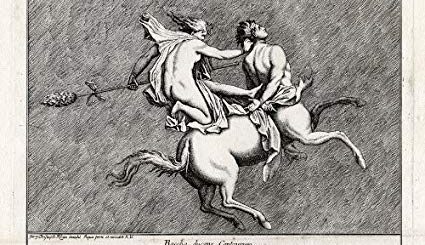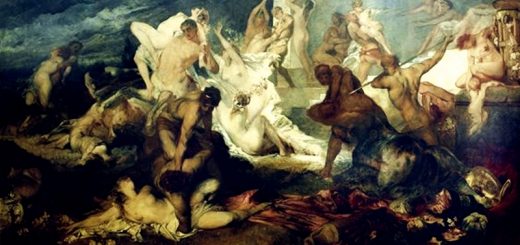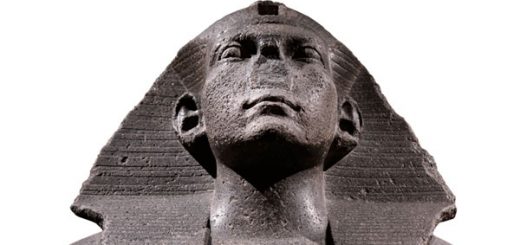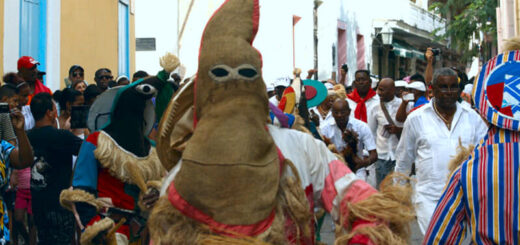Animal ghosts and apparitions
Animal ghosts can actually be the ghosts of deceased animals, like more than one owner of a cat or dog who passed away can testify. Yet in folklore apparitions in the shape of animals are often local daemons like the many animals in European agricultural traditions which mostly act as protectors of the fields, ensuring a good harvest etc. Creatures like the Roggenwolf, Roggensau, Sauzagel, Kornwolf or Roggenhund in Germany.
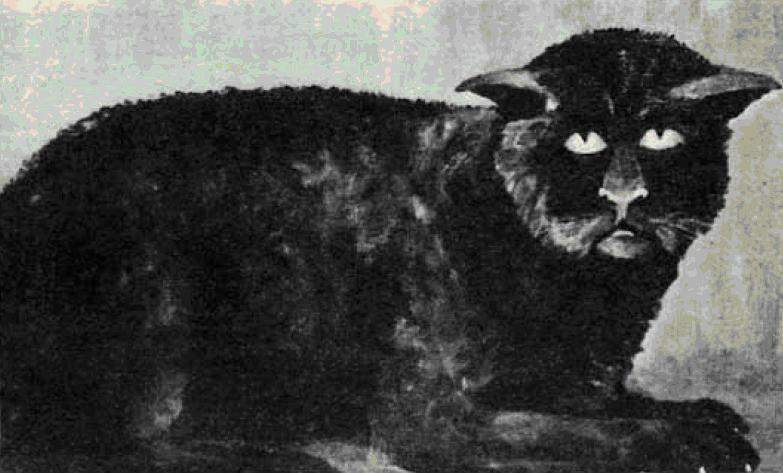
The Hellfire Club in Ireland is supposedly one of the most haunted places in the world. Visitors to the Hellfire Club still report ghostly screams, being poked, prodded and tugged on, as well as the sightings of the Black Cat of Killakee. Described as having a face that is “disturbingly humanoid,” the giant Black Cat is said to haunt the grounds around the ruins of the Hellfire Club.
Tthere are local fairies or daemons in animal shape like the Scottish Kelpie or Hommelstommel (ghostly horse) and Borries (ghost dog with glowing eyes) in the North-Eastern part of the Netherlands. Finally, but now very rare, a specter in the shape of an animal can be the double of a shaman or witch for astral traveling. Over the years this second body can become more dense so that some people actually see the double. These animal phantoms are at the base of stories about werewolves and werefoxes or other were-creatures. Even more rare is the option of a servitor created in animal shape.
For a ghost to take the form of an animal is not at all unusual, and it has also been suggested that human ghosts when they appear in the guise of bulls, dogs, sheep, or other animals are accounted for by being “throw-backs of the spirit to a lower animal form.”
Black dogs, phantom calves and bulls with glowing eyes
Black dogs with glowing eyes like hot embers, phantom calves, white rabbits, etc., are sometimes thought in Lincolnshire to haunt the spots where murder or suicide has been committed. They are supposed to be either spectres of the dead in brute form or demons, and in Denmark there is a legend that pigs or goats, if buried alive in walls, turn to spectres.
In Wales the belief exists that the devil can manifest as a pig, calf, dog, or headless horse. A woman once passing through a village in North Pembrokeshire at night shouted, “Come out, you evil one!” and there appeared a white cat in answer to her call. In the same country a certain Mr. David Walter was passing two large stones called locally the Devil’s Nags, accompanied by a mastiff, when an apparition in the form of a huge dog appeared in his path. He tried to set his own animal upon the other, but the mastiff was frightened and would not attack the phantom. Thereupon Walter picked up a stone and was about to throw it at the evil beast when it was suddenly illumined by a circle of fire, and he knew it to be one of the “infernal dogs of hell.”
A black calf was said to haunt a stream in the same neighborhood and one night two villagers caught the animal and took it home. They locked it up safely as they thought, but in the morning it had disappeared.
The Roaring Bull of Bagbury is a famous Shropshire ghost. Miss Georgina Jackson recites the story as it was told by an old farmer called Hayward.
A very bad man lived at Bagbury Farm, and when he died it was said of him that he had only done two good deeds in his life, one being to give a waistcoat to a poor old man and the other a piece of bread and cheese to a poor village lad. After he was dead, his ghost refused to rest and haunted the farm buildings in the shape of a bull, roaring till the boards, the shutters, and the tiles seemed about to fly off the outhouses. It was quite impossible for anyone to live within range of this roaring which usually began about nine or ten o’clock at night, sometimes even earlier, and at last became so troublesome that the people at the farmhouse sent for twelve parsons to lay the ghost.
When the parsons came “they got him under,” but could not lay him, and at last they drove him, still in the shape of a bull, into Hessington Church. All the parsons carried candles, and one of them, who was blind, knowing that there was danger from a stampede, placed his lighted candle in his top-boot. It was a good thing that he did so, for presently the animal made a great rush, and out went every candle except that belonging to the blind parson who said, as though prepared for the event, “You light your candles by mine.” But before he was laid the bull made such a “burst” that he cracked the wall of the church from top to bottom, as hundreds of witnesses have asserted from that day to this.
At last they secured the ghost “down into a snuffbox,” as the custom is, and he begged that he might be laid under Bagbury Bridge, declaring that every mare that passed over the bridge should lose her foal and every woman her child. This threat made them refuse his request, and they laid him in the Red Sea, where he has to remain for a thousand years. The knowledge that he was so far away did not prevent the villagers being very chary of crossing Bagbury Bridge at night-time.
Another story of a man who turned into a bull after death is told of a squire at Millidrope in Corve Dale. He was killed by a fall from one of the upper windows of the Hall, and an indelible blood-stain marks the spot. Unfortunately for his peace of mind, his estate, owing to his own carelessness or to the malpractices of his trustees, went to the wrong heir. Unable to rest in his grave owing to this piece of injustice, the squire haunted his own parish, where he was frequently seen in the guise of a flayed bull.
An Animal ghost as treasure keeper in the Tower
Edmund Swifte tells a story of an animal ghost in the Tower, which appeared while he was keeper of the Crown Jewels. The peculiar point about the story is that this phantom animal was seen with fatal results. One of the night sentries in the Jewel chamber was alarmed by a figure like a huge bear issuing from beneath the door. He thrust at it with his bayonet, which stuck in the door. Then he fell into a fit and was carried senseless to the guard-room. His fellow sentry declared that the man was neither asleep nor drunk, he himself having seen him the moment before awake and sober. Swifte saw the man in the guard-house after the incident, when he lay prostrated with terror, and two or three days later the poor sentry was dead.
In the outer Hebrides it is believed that demons take the form of dogs, and a story is told of a priest’s dog which was lying on the hearth while his master was hearing confessions. Suddenly the animal started up, annoyed beyond endurance by the atmosphere of ultra-piety and, exclaiming, “If you liked me before, you never will again,” he vanished amidst a shower of sparks.
A Scottish weredog
The Highlanders have also a legend of an ownerless black dog, which caused all kinds of misadventure in the vicinity where he prowled. A hunter shot at the dog with a silver bit, and the aim was so successful that nothing more was seen of the animal. Suddenly a small boy ran up to the hunter with a terrible story of his grandfather who had died within sight of his home as though stricken by a gun-shot wound, and on examination it was found indeed that the silver piece was imbedded in his flesh. There was no further misfortune in the village after this double event, but the tale has more of witchcraft about it than ghostliness.
More ghost dogs
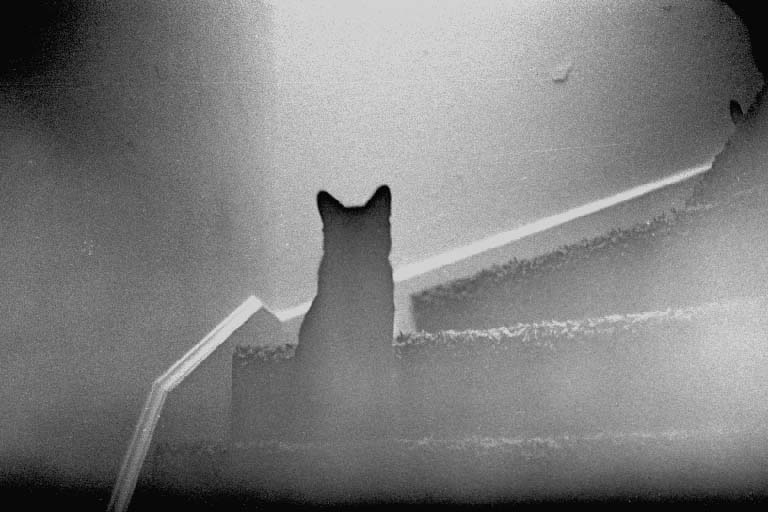
Samuel Drew, who was apprenticed to a shoemaker, had a curious experience at St. Blazey in Cornwall. It is told in his life written by his son.
“There were several of us boys and men, out about twelve o’clock on a bright moonlight night. I think we were poaching. The party were in a field adjoining the road leading from my master’s to St. Austell, and I was stationed outside the hedge to watch and give the alarm if any intruder should appear. While thus occupied I heard what appeared to be the sound of a horse approaching from the town, and I gave a signal. My companions paused and came to the hedge where I was, to see the passenger. They looked through the bushes and I drew myself close to the hedge that I might not be observed. The sound increased, and the supposed horseman seemed drawing near. The clatter of hoofs became more and more distinct. We all looked to see what it was, and I was seized with a strange indefinable feeling of dread: when, instead of a horse, there appeared coming towards us, at an easy pace, but with the same sound which first caught my ear, a creature about the height of a large dog. It went close by me, and as it passed, it turned upon me and my companions huge fiery eyes that struck terror to all our hearts. The road where I stood branched off and on the left there was a gate. Towards the gate the phantom moved, and without any apparent obstruction, went at its regular trot, which we heard several minutes after it had disappeared. Whatever it was, it put an end to our occupation and we made the best of our way home.
“I have often endeavoured in later years, but without success, to account for what I then heard and saw on natural principles. I am sure there was no deception as to the facts. It was a night of unusual brightness, occasioned by a cloudless full moon. The creature was unlike any animal I had then seen, but from my present recollections it had much the appearance of a bear, with a dark shaggy coat. Had it not been for the unearthly lustre of its eyes, and its passing through the gate as it did, there would be no reason to suppose it anything more than an animal perhaps escaped from some menagerie. That it did pass through the gate without pause or hesitation I am perfectly clear. Indeed we all saw it, and saw that the gate was shut, from which we were not distant more than about twenty or thirty yards. The bars were too close to admit the passage of an animal of half its apparent bulk, yet this creature went through without an effort or variation of its pace.”
Peele Castle in the Isle of Man is haunted by an apparition called the Manx dog, a shaggy spaniel, which was said to walk in every part of the building, and to lie in the guard-chamber before the fire by candlelight. In days gone by the soldiers were accustomed to the apparition, but all the same they suspected it was an evil spirit, and all were afraid to be left alone in its presence, and were also careful of the language they used lest they should receive an injury if they swore before it. The animal used to appear and return by a passage in the church, and as this passage was also used by the soldier who had to deliver the keys to the captain, and he was terrified at the thought of meeting the phantom, it was arranged that he should have a companion, and after that they went two by two, never singly.
One night one of the soldiers who had been drinking and was in a bragging mood, declared that he would carry back the key alone, though it was not really his turn to go. He would not listen to the others, who tried to dissuade him. Blustering and swearing, he snatched up the bunch of keys and marched off. Presently a great noise was heard outside, but the soldiers were too frightened to go out and see what was taking place. In staggered the adventurous boaster, struck dumb with horror at what he had seen, nor could he by sign or word explain what had happened to him, but died, in terrible agony, his features distorted and his limbs writhing.
After this occurrence no one would venture through the passage, which was soon bricked up, and the apparition never appeared again in the castle.
Hergest Court, in Herefordshire, was haunted by a demon dog said to have belonged to Black Vaughan. Black Vaughan was himself said to be the ghost of the member of the family whose monument rests in Kingston Church. So powerful was this ghost that he appeared in daylight and upset farmers’ waggons, or rode with the old wives to Kingston Market. Once he was said to have appeared in church in the form of a bull, and the usual elaborate form of exorcism was required to dislodge him, in which twelve parsons with twelve candles had to remain in the church until they had “read him down into a silver snuff-box.” The demon dog always appeared as a warning that death was nigh to one of the Vaughan family.
The Black Dog of Hergest was famous all over the country-side, and no one ventured to enter the room he was said to haunt. At night he clanked a chain, but at other times he was seen wandering about without one, often near a pond on the high road to Kingston.
Another phantom dog-story comes from the parish of Dean Prior, a narrow woodland valley watered by a stream. Below a beautiful cascade is a deep hollow called the Hound’s Pool. At one time there lived near to this spot a skilful weaver. After his death he was seen by his family working as diligently as ever at his loom, and, this being regarded as uncanny, application was made to the vicar of the parish as to what steps were to be taken to remove the apparition. The parson called at the cottage where the weaver had lived and, hearing the noise of the shuttle in the upstairs room, called to the ghost of the weaver to descend.
“I will,” replied the weaver’s voice, “as soon as I have worked out my shuttle.”
“No,” replied the vicar, “you have worked long enough. Come down at once.”
So the phantom appeared, and the vicar, taking a handful of earth from the churchyard, threw it in his face. In a moment the apparition turned into a black hound. “Follow me,” said the vicar, and the dog followed to the gate of the wood, where a mighty wind was blowing. The vicar picked up a nutshell with a hole in it and leading the hound to the pool below the cascade, said, “Take this, and dip out the pool with it. When it is empty thou shalt rest.”
The hound still haunts the spot, and to those who can see is ever at work on the waters of the pool.
Similarly Tregeagle, the famous Demon of Dosmery Pool, in Cornwall, is doomed to empty the pool with a limpet shell which has a large hole in it.
A story is told of a talking Dog which haunted Dobb Park Lodge.
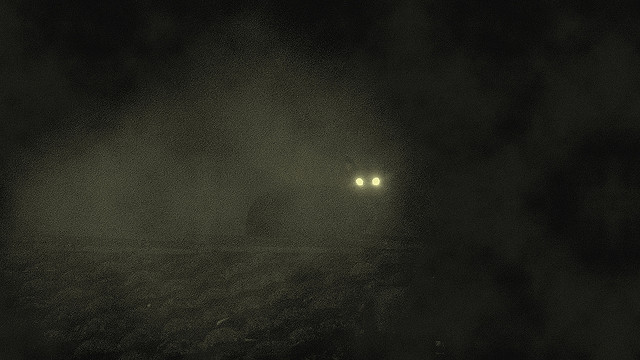
Ghost cat
A treasure-seeker who went to explore the underground vaults at the Lodge saw a great, black, rough dog as large as any two or three mastiffs, which said, “No, my man, as you’ve come here, you must do one of three things, or you’ll never see daylight again. You must either drink all the liquor there is in that glass, open that chest, or draw that sword.”
The chest was iron-bound and too heavy to move, the drink was scalding hot, and the sword glittered and flashed like lightning wielded by an unseen hand. Fortunately the treasure-seeker escaped after extraordinary experiences with his bare life, returning as empty-handed as he came, and since then no one has ventured into the ruined vaults of Dobb Park Lodge, and the chest of gold is said to be still there, waiting for an adventurer who can brave the terrors of the “Talking Dog” and his surroundings.
The neighbourhood of Burnley used to be haunted by a phantom locally called “Trash” or “Striker.” These names came from the sounds made by the animal which had the appearance of a large dog with broad feet, shaggy hair, drooping ears and “eyes as large as saucers.” His paws made a splashing noise as of old shoes on a muddy road, and now and again the brute emitted deep howls. His presence was considered a certain sign of death in the family of anyone who caught sight of the apparition. If followed by anyone the animal began to walk backwards, keeping his eyes on the pursuer. At the slightest inattention on the part of his companion the phantom vanished. Sometimes he plunged into a pool of water, at others he dropped at the feet of the pursuer with a curious splashing sound. Some attempted to strike the animal, but there was no substance present to receive the blow, though the apparition remained in the same position as before the blow was delivered.
Some animal ghosts appear in different shapes at different times.
The Manor of Woodstock was haunted in 1649 by an apparition described by several witnesses whose narratives may be found in Dr. Plott’s “Natural History of Oxfordshire.”
Commissioners took up residence at the Manor House on 13 October, 1649, but heard nothing of the ghost until three days later when “there came, as they thought, somewhat into the bedchamber (where two of the commissioners and their servants lay), in the shape of a dog, which, going under their beds, did as it were gnaw their bed cords, but on the morrow finding them whole and a quarter of beef, which lay on the ground, untouched they began to entertain other thoughts.” On the following day, the 17th, some evil spirit hurled the chairs and stools up and down the Presence Chamber, “from whence it came into the two chambers where the commissioners and their servants lay and hoisted their beds’ feet so much higher than their heads that they thought they should have been turned over and over; and then let them fall down with such force, that their bodies rebounded from the bed a good distance.”
The next day also a mysterious visitor appeared to be present, which fetched the warming-pan out of the withdrawing-room and made so much noise “that they thought five bells could not have made more.” On the 20th and 21st of October various phenomena occurred, and then came a respite until the 25th, on the night of which, amongst other curious sounds and sights, there was “a very great noise as if forty pieces of ordnance had been shot off together.” Peace was restored until the 1st of November when “something came into the withdrawing-room, treading, as they conceived, much like a bear, which at first only walked about a quarter of an hour: at length it made a great noise about the table and threw the warming-pan so violently, that it quite spoiled it. It threw also glass and great stones at them again, and the bones of horses, and all so violently that the bedstead and walls were bruised by them.” This night they set candles all about the rooms, and made great fires up to the mantle-trees of the chimneys, but all were put out, nobody knew how. Nor was this all. For in spite of the fact that one of the commissioners had the boldness to ask in the name of God what it was, what it would have, and what they had done, that they should be disturbed in this manner, and the questions, although evoking no answer, caused a temporary cessation of noise, it returned bringing seven devils worse than itself. Whereupon one of the watchers lighted a candle and set it between two rooms in the doorway, on which another of them “fixing his eyes saw the similitude of a hoof, striking the candle and candlestick into the middle of the bedchamber and afterwards making three scrapes on the snuff to put it out. Upon this the same person was so bold as to draw his sword, but he had scarce got it out, when there was another invisible hand had hold of it too, and tugged with him for it and prevailing, struck him so violently with the pummel that he was stunned with the blow.”
This was too much, and two days later the commissioners and their men removed out of the house, unable to stand the strain they were undergoing any longer.
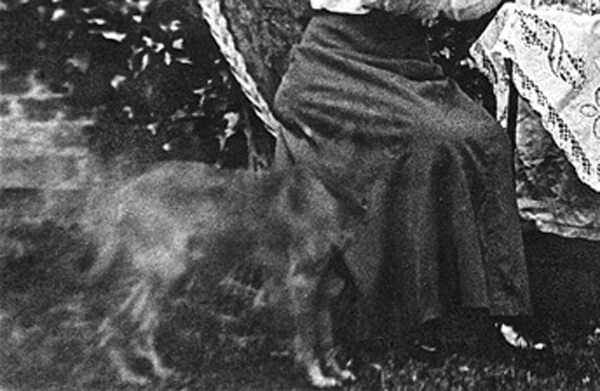
Ghost of a dog
An apparition of a lady in the form of a colt is somewhat unusual, but has been seen, if we may believe the statement of a woman called Sarah Mason. Sarah also saw the ghost of a man who hanged himself and came back afterwards in the form of a large black dog.
The story of Obrick’s Colt concerned a lady who was buried with all her jewels and whose corpse was afterwards robbed by the clerk. She haunted the spot, it was said, in the shape of a colt, and the guilty clerk, meeting the phantom animal late one night in a narrow lane, went down on his knees, and said earnestly, “Abide, Satan, abide. I am a righteous man and a psalm-singer.” The clerk was called Obitch or Holbeach, from which the ghost is supposed to have taken the name of Obrick’s Colt. An old woman in the village declared that “Obitch used to say that he saw the colt as natural as any Christian, and he used to get up against the stile for him to get up on top of his back, and at last the colt grew so bold that folks saw him in the daytime.” Holbeach, if that was his real name, never again knew peace of mind on this earth.
On the 21st of January, 1879, a labourer had taken some luggage from one Shropshire village to another, and on the return journey, his horse being tired, he reached a canal bridge some way from home about ten o’clock at night. To his horror a huge black creature with gleaming white eyes jumped out of the hedge and settled on the horse’s back. He beat at the phantom with his whip, which, to his astonishment, instead of meeting with resistance went through the apparition. The terrified horse broke into a canter and tore home with the strange creature clinging to his back.
The adventure was much discussed in the neighbouring villages, and some days later the labourer’s master was called upon by a policeman who had somehow got knowledge of an account that he had been robbed when crossing the canal bridge in question late one evening. The policeman was told there had been no robbery, and a version of the tale as it had happened was given him.
“Was that all?” he cried in disappointed tones. “I know what that was. It was the man-monkey, sir, as does come at that bridge ever since a man was drowned in the canal at that spot.”
The following story was told to Bérenger-Feraud and happened at a country house on the plateau of the Garde near to Toulon. One evening a woman was sitting by the side of her father who had been lying dangerously ill in bed for some days with a disease which the doctors could not identify. The neighbours came in to offer their services, to keep watch over the sick man so that his daughter, who had spent several nights without any sleep, could go and lie down to rest. She thanked them but refused to do so.
Nevertheless they insisted on remaining, and as it was cold she invited them to sit round the fire in the kitchen to warm themselves. As her father seemed to be asleep for a little while she went into the kitchen to speak to her visitors.
Of a sudden they heard the sick man give a terrible cry of pain and fright. They all hurried into his room to see what was the matter, and there, just above the old man’s bed, was a huge stinging-fly which hovered round and round him, buzzing in a horrible manner.
They tried to catch the dangerous insect, but this was not an easy matter, for it buzzed so loudly that it positively menaced those who came near it. From time to time it hurled itself at the limbs of the sick man, and every time it touched him he gave vent to a shriek of pain. Those who were near him could see large black blisters rising at the spots where the stinging-fly attacked him.
At last one of the men who had more courage than the others beat down the gigantic insect with his hat. They picked up its body with a pair of tongs and threw it out of the house, shutting the door tightly so that it could not return to its attack.
The deed accomplished, they looked at one another terrified at what had taken place, and to their horror they could plainly hear the buzz of the insect outside. The noise was so loud that the windows positively rattled. Then a howl arose outside, a cry so strange that no one present had ever heard the like, and after that all was silent.
They went back to the bedside of the sick man, who had suffered severely, and who told them that he had been suddenly awakened by this horrible stinging-fly, which had hummed in his ears and struck at his body, in such a terrifying manner that he felt sure it must be an evil spirit.
Now that the insect had been captured and put out of the house he felt better, but none of the visitors dared to leave the cottage, feeling sure that a sorcerer was mixed up in the affair. They passed the night sitting round the fire, carefully avoiding all mention of the matter, as they were afraid that the noise of buzzing and humming would begin afresh.
The next morning at sunrise, they decided to open the door, and then they saw the huge insect lying on the ground just outside. But the mysterious part of it was that those who were courageous enough to look at it closely, stated that it was not the real insect that was lying there but merely its outer shell or covering, just like the skin sloughed by a grasshopper and left behind when it changes its shape.
This then was taken to be proof positive that the stinging-fly was not what it had pretended to be, but was a wizard in disguise, which had intended to do harm to the old invalid, and the horrible cry which had been heard when the insect had been thrown out of doors was only the howl of rage uttered by the wizard at the failure of his wicked designs.
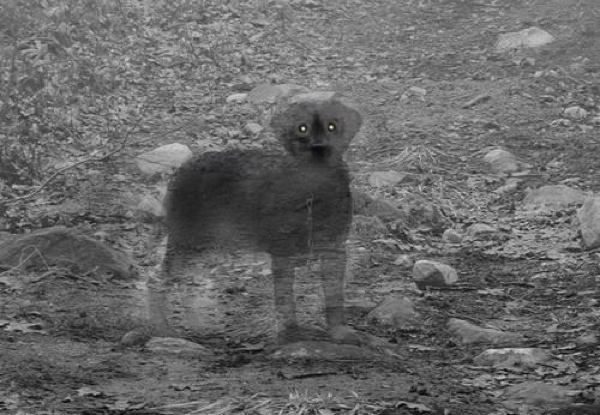
Ghost doggy
A woman at Toulon told the following story in 1888, saying it had happened in her presence when she was a little girl. Her father, whose name was Isidore, was an omnibus driver and for many years had lived with his own sister in peace and friendliness. One day, however, they fell into an argument and had such a violent quarrel that they decided that they could no longer live together. Isidore, however, felt grieved to think that matters had come to such a pass between himself and the sister he had always loved, and he told a friend about the affair. The friend answered, “You have quarrelled with your sister, because one of your neighbours, who is a sorcerer, has cast a spell over you. To end the enchantment you must give your horses a jolly good hiding to-morrow morning, and then you will see the result. The person who has bewitched you will be taken ill and will bear about his or her body the traces of the blows you give to your horses.” Next day Isidore whipped up his horses, as he had been told to do, and he went on slashing them all day long. In the evening he went to bed feeling as though he had done a praiseworthy deed. The next day his sister came to see him and spoke to him quite affectionately, and they decided to bury the hatchet just as though no quarrel had taken place. Then Isidore, to his surprise, heard that a neighbour, of whom he had been very fond until then, and whom he had not in the least suspected of witchcraft, had been taken ill. He hastened to visit her, and found she was in bed, and that she showed traces of having been beaten. As soon as he entered the room to condole with her she said to him bitterly, “Why on earth did you strike your horses so violently? What harm had the poor beasts done to you?”
This was taken as proof that the neighbour was a witch, and that the weals on her body were the stigmata of the blows which Isidore had given his horses, and he was convinced that this woman had tried to separate him from his sister through sheer jealousy.
The well-known ghost of Tedworth, Wiltshire, called the “Drummer of Tedworth,” sometimes took the form of an animal, or at least was heard making animal sounds. The following description is taken from Joseph Glanvill’s “Sadducismus Triumphatus.”
On one occasion the village blacksmith stayed in the house sleeping with the footman, hoping he might hear the supernatural noises and be cured of his incredulity when “there came a noise in the room as if one had been shoeing a horse, and somewhat came, as it were, with a pair of pincers,” snipping away at the sceptical smith. Next day the ghost came panting like a dog out of breath, and a woman who was present, taking up a stick to strike at it, the weapon “was caught suddenly out of her hand and thrown away: and company coming up, the room was presently filled with a bloody noisome smell,” and was very hot, though there was no fire, and the winter was severe. “It continued scratching for an hour and a half and then went into the next room, when it knocked a little and seemed to rattle a chain.”
Sometimes the phantom purred like a cat and it was described by a servant as “a great body with two red and glaring eyes.”
The Rev. Joseph Glanvill himself went to the haunted house in January, 1662, and was convinced that the noises were made by a demon or spirit. He heard a strange scratching, as he went upstairs, which appeared to come from behind the bolster of the children’s bed. It was loud scratching, and when he thrust his hand behind the bolster at the point from which the noise seemed to come it ceased but began in another place. When he removed his hand, however, it began again in the same place as before. “I had been told that it would imitate noises,” says Glanvill, “and made trial by scratching several times upon the sheet, as five, and seven and ten, which it followed, and still stopped at my number. I searched under and behind the bed, turned up the clothes to the bed cords, grasped the bolster, sounded the wall behind, and made all the search I possibly could.” But all his endeavours were fruitless; he could discover nothing. There was neither cat nor dog in the room. After scratching for more than half an hour, the phantom went into the midst of the bed, under the children, “and then seemed to pant very loudly, like a dog out of breath. I put my hand upon the place and felt the bed bearing up against it, as if something within had thrust it up.” The motion it caused by this panting was so strong that it shook the walls and made the windows rattle; yet this strange animal ghost was never explained.
At Epworth parsonage, Lincolnshire, when the Rev. Samuel Wesley, father of John Wesley, was rector, there is a well-known story of the haunting of the parsonage. Robert Brown the servant heard, among other phenomena, “as it were the gobbling of a turkey-cock close to the bedside.”
The dog, a large mastiff, showed enormous fear of the strange incidents and apparitions. “When the disturbances continued he used to bark and leap and snap on one side and the other, and that frequently before any person in the room heard any noise at all. But after two or three days he used to tremble and creep away before the noise began. And by that the family knew it was at hand.”
Ewshott House, in Crondall, Hampshire, was haunted by a ghost that made a noise exactly as though a flock of sheep from the paddock had rushed by the windows on the gravel drive. In the morning, however, there were no signs of sheep having passed that way.
Willington Mill was haunted by several spectres in the shape of animals. The mill stood on a tidal stream which ran into the Tyne near to Wallsend. The account of strange happenings there was published by the “Newcastle Weekly Leader” many years ago. One of the servants once saw a lady in a lavender-coloured dress pass the kitchen door, go upstairs, and vanish into one of the bedrooms, but little notice was taken of this apparition; indeed it was almost forgotten when something else happened which drew attention to it. A certain Thomas Davidson was courting this servant and was waiting for her to come out of the mill and join him in a moonlight ramble, when, looking towards the building, he distinctly saw a whitish cat run out and presently it came close to his feet.
Thinking the strange puss was very forward, he gave her a kick, but encountered no solid matter and puss continued her walk, disappearing from his sight a moment later. Returning to the window, and looking in the same direction, Davidson again saw the animal. This time it came hopping like a rabbit, coming quite as close to his feet as before. He determined to have a good rap at it, and took deliberate aim: but, as before, his foot went through it and he felt nothing. Again he followed it, and it disappeared at the same spot as its predecessor. The third time he went to the window and in a few moments it made another appearance, not like a cat or rabbit now but as large as a sheep and brightly luminous. On it came and Davidson stood rooted to the spot as though paralysed, but the animal moved on and vanished as before.
Mr. Proctor, who lived at the mill, on hearing Davidson’s account, said that he had seen the animal on various occasions.
After this experience ghosts were frequently seen and heard of at the mill. The noises were dreadful, sometimes sounding like a galloping donkey, at others like falling fire-irons. Doors creaked and sticks crackled as though burning, and the rapping became almost incessant. Sometimes the lavender-gowned lady appeared, and at another time several of the inmates of the mill saw a bald-headed old man in a flowing robe like a surplice. Spectral animals always formed an important feature of the haunting.
In November, 1841, a gentleman paid a visit to the place and was confronted by the figure of an animal about two feet high, which appeared in a window. After careful search nothing was found, though the animal was seen in the window by others from the grounds for half an hour, after which it slowly faded away. A two-year-old child saw a ghost kitten, while Davidson’s aunt thought the spectre looked like a white pocket handkerchief, knotted at four corners, which danced up and down, leaping as high as the first floor window. This lady was one day standing by the kitchen table when she was startled by the bark of a dog, and two paws were laid heavily on her shoulders, so that she had to lean against the table for support. No dog, however, was found in the house. On several occasions the children, though nothing had been said to them about ghosts, found amusement in chasing up and down the stairs some animal they described either as a “funny cat or a bonny monkey.”
In 1853, an attempt was made to discover the secret of the mystery of the mill by a clairvoyante, who in her trance distinctly saw, the “lady like a shadow, with eyes but no sight in them,” as she described her, as well as a number of animals. When questioned about these, she answered, “One is like a monkey and another like a dog. Had the lady dogs and monkeys? They all go about the house. What is that other one? It is not a pussy, it runs very fast and gets amongst feet. It is a rabbit but a very quick one.” When asked whether the animals were real, the medium replied in her quaint way, “We don’t touch them to see, we would not like a bite.”
Beyond this there appears to have been no solution as to the mystery of the haunted mill, although the medium declared that the trouble “came from the cellar.”
A writer in “Notes and Queries,” H. Wedgewood by name, visited Mr. Proctor in 1873-4 to ask him the truth about the Willington Mill ghost, and he told her that he had seen a tabby cat in the furnace room. There was nothing unusual in the animal’s appearance, and it would not have caught his attention particularly had it not begun to move. But then instead of walking like an ordinary cat it wriggled along like a snake. He went close to it and followed it across the room, holding his hand about a foot above it, until it passed straight into the solid wall.
The well-known Cornish tradition says that if a young woman dies neglected after being betrayed by her lover, she haunts him after her death in the form of a white hare. The false lover is continuously pursued by the phantom. At times it may rescue him from danger, but in the end it is the cause of his death.
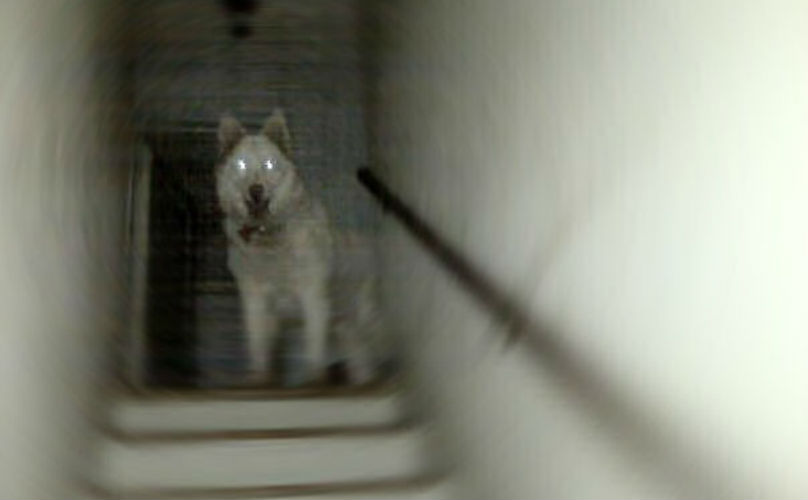
Ghost dog on the stairs
The following story of a phantom hare pursuing a false lover to his death is told by Robert Hunt in “Popular Romances of the West of England.”
A young farmer settled at a fine new farmhouse and a peasant’s daughter was placed there in charge of the dairy. The young farmer fell deeply in love with her and she with him, and he betrayed her under a promise of marriage, but his family refused to agree to the alliance taking place, and provided a bride for him suitable to his station. The dairymaid was sent away ignominiously when it was known she was about to become a mother. One morning the corpse of a newly-born infant was found in the farmer’s field and the dairymaid was accused of strangling her child, and was finally convicted of murder and executed.
But ever after that day ill-fortune pursued the young farmer who had behaved in such a cowardly way, and though he removed to another part of the country, none of his projects prospered. Gradually he took to drink to drown his secret sorrows. He generally went out at dusk and it was noticed that a white hare constantly crossed his path. The animal was seen by many of the villagers to dart under the hoofs of his horse, and the terrified steed rushed madly forward whenever this phantom appeared.
A day came when the young farmer was found drowned in a pool at the bottom of a forsaken mine, and the frightened horse was still grazing near the mouth of the pit into which his master had fallen.
The woman he had betrayed and left to die a shameful death, having assumed the shape of a white hare, had haunted the perjured and false-hearted farmer to his death.
It is said that fatal accidents in mines are often foreshadowed by the appearance of a white hare or rabbit. At Wheal Vor, writes Mr. Hunt, in “Popular Romances of the West of England,” it has always been and is now believed that a white rabbit appears in one of the engine houses when an accident may be looked for in the mine. The men say that they have chased the phantom animals without being able to catch them, and on one occasion the rabbit ran into a “windbore” which lay on the ground and escaped. Similarly in a French mine one of the miners saw a white object run into an iron pipe and hide there. He hastened forward and stopped up both ends of the tube, calling to a companion to examine the pipe. But the animal ghost had disappeared and nothing remained to explain what had taken place.
The devil appeared in the form of a hare at the hanging of two men on Warminster Down in 1813, it was said. At Longbridge the devil appeared in the form of a dog one Palm Sunday, according to the account of a labourer, who when questioned as to how this was proved, exclaimed, “Sum’at was there anyhow, and we all fled!”
A farmer in South Wilts who died about 1860, threatened to revisit his farm on a lonely moor and run about in the shape of a rat. The story does not say what he expected to gain by choosing this particular animal for transformation purposes.
Superstition gives to white birds a particular power of conveying omens.
A small white bird plays a part in warning an old harper in Wales of the destruction of a prince’s palace, whither the bard had been invited to perform at festivities held on the occasion of the birth of an heir.
Tradition relates that Bala Lake was formed as a means of submerging a palace where lived a cruel and wicked prince, who practised oppression and injustice upon poor farmers of the district. The tyrant often heard a ghostly voice urging him to desist from his evil ways and saying, “Vengeance will come,” but he treated the warning with contempt.
On the occasion of his son’s birth, there was great rejoicing at the palace, and the poor harper was called in to play to the guests. Mirth, wine, feasting, and dancing continued till a late hour, and during the interval in which the harper was allowed to rest, he retired into a quiet corner, where, to his astonishment, he heard a whisper in his ear, “Vengeance, vengeance!” Turning to discover whence the sound came, he observed a tiny white bird hovering about him, urging him, as it were, to follow. He fell in with the creature’s wishes without stopping to fetch his harp, and the bird led him beyond the palace walls, still singing in a plaintive note the word “Vengeance, vengeance!” Over marshland, through thickets, across streams and up ravines this strange pair wandered, the bird seemingly choosing the safest path for her companion, and growing ever more insistent in her cries of “Vengeance, vengeance!” At last they came to the summit of a hill some distance from the palace. Utterly weary the harper ventured to stop and rest, and the bird’s voice was heard no more, but as he listened he could distinguish the loud murmur of a brook.
Suddenly he awoke to the fact that he had allowed himself to be led away foolishly, and he attempted to retrace his steps. In the dark, however, he missed his way and was forced to await daylight. Then to his surprise he turned his eyes upon the valley in which the palace had stood and discovered that it was no longer to be seen, for the waters had flooded the face of the land, and on the placid lake that lay in the valley his harp was floating.
Another story of birds that foreshadowed a calamity is told about Yorkshire. A writer in “Notes and Queries” passed through the district of Kettering on September 6, and noticed an immense flock of birds which flew round and round, uttering dismal cries. He spoke of the matter to his servant, who told him the birds were called the “Seven Whistlers,” and that whenever they were heard a great calamity might be expected. The last time he had heard them was the night before the great Hartley Colliery explosion. Curiously enough the writer, on taking up the newspaper the following morning, saw an announcement of a terrible colliery explosion at Wigan.
On the Bosphorus the boatmen say, with reference to certain flocks of birds which fly ceaselessly up and down the channel, never resting on land or water, that they are the souls of the damned, doomed to perpetual motion.
A strange bird-ghost is connected with the lake and house of Glasfryn. On a certain evening, Grassi, which is the phantom’s name, forgot to close the well and the waters overflowed and formed a lake. There she wanders at night bemoaning her carelessness. She also visits the house as a tall lady with well-marked features, large, bright eyes and dressed all in white. Another version of the story is that when the water overflowed and the lake was formed, the fairies seized Grassi and changed her into a swan and she continued to live by the waters for more than a century and died still lamenting her lot. Another version runs that the lady was changed into a swan as a punishment for haunting the house.
Holt Castle, in Worcestershire, is said to have been haunted by a mysterious lady in black who walked through a passage which led to the attics, while the cellar was in the possession of a phantom bird, not unlike a raven, which occasionally pounced upon the servants who went to draw beer or cider from the casks there. By flapping his wings, the unholy bird extinguished the candle of the adventuresome human being who invaded his domain, and then vanished, leaving his victim prostrated with fear.
York Castle was the scene in which an extraordinary ghost took animal shape. The story is told in the Memoirs of Sir John Reresby.
“One of my soldiers being on guard about eleven in the night at the gate of Clifford Tower, the very night after a witch had been arraigned, he heard a great noise in the castle; and going to the porch there saw a scroll of paper creep from under the floor, which, as he imagined by moonshine, turned first into the shape of a monkey, and thence assumed the form of a turkeycock, which passed to and fro by him. Surprised at this, he went to the prison and called the under-keeper, who came and saw the ‘scroll’ dance up and down, and creep under the door, where there was scarce an opening of the thickness of half a crown. This extraordinary story I had from the mouth of both one and the other.”
Among the curiously shaped phantoms are those which have an important part of their anatomy lacking, and most common of all are the ghosts, human and animal, that are seen without a head. Indeed the belief in headless spectres, both of equine and canine beings, is remarkably widespread throughout England.
The Rev. Richard Dodge, a Cornish clergyman, who lived near Looe, was an exorcist, and was said to be able “to drive along evil spirits of various shapes, pursuing them with his whip.” One day his services were commanded by a Mr. Mills, Rector of Lanreath, who said that labourers had been startled by an apparition of a man in black garb driving a carriage drawn by headless horses. Mr. Dodge met Mr. Mills, but as they saw no apparition, they parted to return to their respective homes. Mr. Dodge’s horse grew restive and refused to proceed, so he, thinking something uncanny was about to take place, allowed the animal to return to the spot where he had parted from Mr. Mills, whom, to his distress, he found lying prostrate on the ground with the spectre and his black coach and headless horses beside him.
Jumping down to assist his friend, Dodge uttered a prayer, and the spectre screaming, “Dodge is come, I must be gone,” whipped up the ghost horses and vanished into the night.
Spectre huntsman
Spectre horsemen are common and one is said to haunt Wyecoller Hall. The ghost is dressed in the costume of the Stuart period, and the trappings of the horse are of uncouth description. On windy nights the horseman is heard dashing up to the Hall. The rider dismounts, makes his way up the stairs into a room on the first landing, whence presently screams and groans issue. Suddenly the horseman reappears and gallops off, the horse appearing wild with rage, its nostrils streaming fire. The tradition is that one of the Cunliffes of Billington, for long the owners of Wyecoller Hall, near Colne, murdered his wife and reappears every year as a spectre horseman in the home of his victim. She is said to have predicted the extinction of the family, a prediction long since fulfilled.
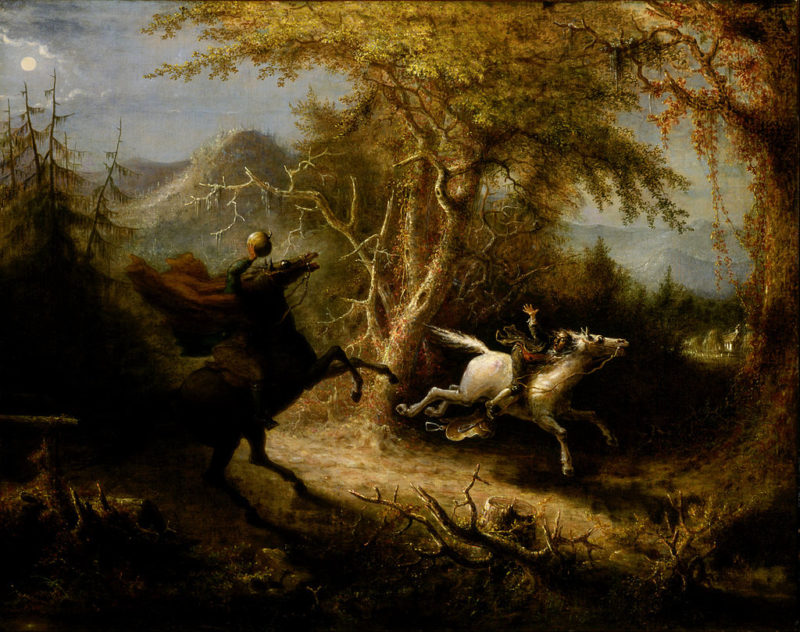
The Headless Horseman Pursuing Ichabod Crane, painting by John Quidor (1858)
The midnight hunter and his headless hounds are often to be seen in Cornwall, and the Abbot’s Way, on Dartmoor, is said to be a favourite spot for their visitations. Sir Francis Drake was supposed to drive a hearse into Plymouth by night, followed by a pack of headless, but nevertheless howling, hounds. On Cheney Downs in the parish of St. Teath, ghostly hounds said to have belonged to an old squire called Cheney, were often seen and heard, especially in rough weather.
Herne, the ghostly hunter of Windsor Forest, has his counterpart in the Grand Veneur of Fontainebleau. While hunting in his favourite forest, Henry II of France was suddenly startled by the sound of horns, and the cries of huntsmen and the barking of dogs. At first they sounded far away, but soon they came close by. Some of the company in advance of the king “saw a great black man among the bushes,” crying in sepulchral tones, “M’attendez-vous?” or “M’entendez-vous?” or “Amendez-vous.” The king, startled, inquired of the foresters and peasants what they knew of the apparition. He was informed that they had frequently seen the rider, accompanied by a pack of hounds, which hunted at full cry, but never did any harm.
Dan gives Pierre Matthieu’s version of the story and adds, “I know what several authors narrate concerning the hunt of Saint Hubert, which they declare is heard in various parts of the forest. Nor do I ignore what they say of the spectre called the ‘Whipper,’ which was supposed to appear in the time of Charles IX in the forest of Lyons, and which left the mark of the lash on several people. Nor do I doubt that demons may wander in the forest as well as in the air. But I know well as regards the ‘Grand Veneur’ nothing is certain, least of all the circumstances in which, according to the reports of the authors, this phantom appears, and the words of which he makes use.”
The spectre huntsman chasing the wild doe and the headless hounds in full cry are amongst the many prominent demon superstitions still extant and the chief legends concerning them, with their variants, are mentioned by Charles Hardwick in “Traditions, Superstitions, and Folk-lore.” The appearance of these and other animal spectres, however, has never been satisfactorily explained, and the question that naturally occurs to the student after reading such stories is whether animals are able to send forth astral or phantasmal doubles in a manner similar to that in which it is believed human beings can project them.
Main text adjusted for blog taken from “Human Animals” by Frank Hamel
You may also like to read:
Black dog apparitions
Historical werewolf cases in Europe
Thought forms – Thoughts condensed on purpose or by accident
Poltergeist
Mountain spirits
Allan Kardec: Life after death as a science…
Black cat superstitions
The real vampire in Russia and Slavonic countries


